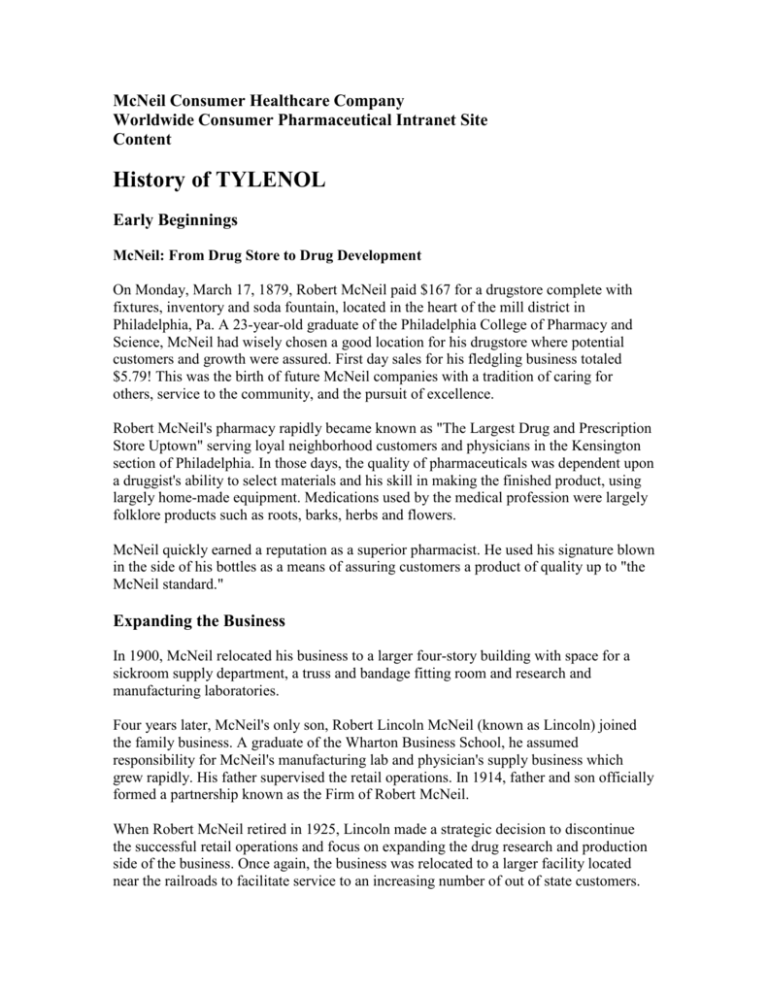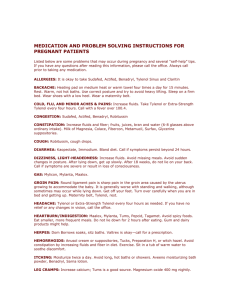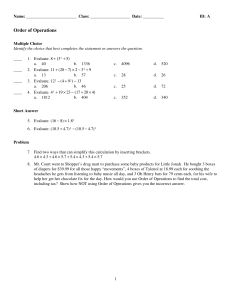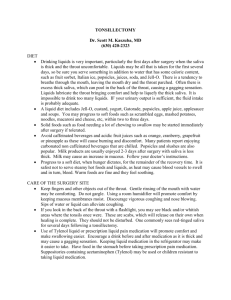History of TYLENOL - Nancy West Communications
advertisement

McNeil Consumer Healthcare Company Worldwide Consumer Pharmaceutical Intranet Site Content History of TYLENOL Early Beginnings McNeil: From Drug Store to Drug Development On Monday, March 17, 1879, Robert McNeil paid $167 for a drugstore complete with fixtures, inventory and soda fountain, located in the heart of the mill district in Philadelphia, Pa. A 23-year-old graduate of the Philadelphia College of Pharmacy and Science, McNeil had wisely chosen a good location for his drugstore where potential customers and growth were assured. First day sales for his fledgling business totaled $5.79! This was the birth of future McNeil companies with a tradition of caring for others, service to the community, and the pursuit of excellence. Robert McNeil's pharmacy rapidly became known as "The Largest Drug and Prescription Store Uptown" serving loyal neighborhood customers and physicians in the Kensington section of Philadelphia. In those days, the quality of pharmaceuticals was dependent upon a druggist's ability to select materials and his skill in making the finished product, using largely home-made equipment. Medications used by the medical profession were largely folklore products such as roots, barks, herbs and flowers. McNeil quickly earned a reputation as a superior pharmacist. He used his signature blown in the side of his bottles as a means of assuring customers a product of quality up to "the McNeil standard." Expanding the Business In 1900, McNeil relocated his business to a larger four-story building with space for a sickroom supply department, a truss and bandage fitting room and research and manufacturing laboratories. Four years later, McNeil's only son, Robert Lincoln McNeil (known as Lincoln) joined the family business. A graduate of the Wharton Business School, he assumed responsibility for McNeil's manufacturing lab and physician's supply business which grew rapidly. His father supervised the retail operations. In 1914, father and son officially formed a partnership known as the Firm of Robert McNeil. When Robert McNeil retired in 1925, Lincoln made a strategic decision to discontinue the successful retail operations and focus on expanding the drug research and production side of the business. Once again, the business was relocated to a larger facility located near the railroads to facilitate service to an increasing number of out of state customers. The new building was a model pharmaceutical plant designed for manufacturing products of the highest quality with the most modern equipment. Focus on Physicians After Robert McNeil's death in 1933, the company was incorporated under the name McNeil Laboratories, Inc. with Robert Lincoln McNeil serving as its first president. Lincoln's eldest son, Robert Lincoln McNeil, Jr. (Bob), joined the company in 1938 after graduating from Yale University with a degree in physiological chemistry. As the first member of McNeil's research department, his primary focus was to analyze and trim the product line from 1,400 items to 100 quality items. A second son, Henry S. McNeil, joined the company in 1939. Also a Yale graduate with a degree in applied economic science, he focused on sales, converting the company's business from direct selling to "detailing" physicians, a new business approach that was very successful. During the same period, McNeil introduced BUTISOL SODIUM, a daytime sedative which was the company's leading product from 1948 to 1969. It was the first McNeil product to reach $1 million in sales. TYLENOL Launch and J&J Acquisition In 1955, McNeil Laboratories introduced TYLENOL Elixir for Children, first in a line of products that was to become the nation's best selling analgesic. In the same year, Robert Lincoln McNeil retired. His sons, Henry and Bob, carried on as president and chairman of the board respectively. By 1957, the company needed more space once again. McNeil acquired a 110-acre tract of land in Fort Washington, Pa. and construction of a new plant took place over the next four years. In 1959, Johnson & Johnson acquired McNeil Laboratories. At the time, net sales were $11.4 million and the sales force numbered 225. The escalating cost of research was a primary factor in the decision to sell the privately held family company. For more detailed information, go to McNeil: The Evolution of a Family Company. To continue, go to APAP and the Development of TYLENOL. Brand Essence Major Milestones Worldwide Expansion Future Expectations APAP and the Development of TYLENOL Evolution of a Name TYLENOL is the brand name for a non-prescription analgesic (pain reliever) and antipyretic (fever reducer) manufactured by McNeil Consumer Healthcare. The active ingredient used in TYLENOL products is acetaminophen. The trademark TYLENOL was created by McNeil's professional sales team using some of the letters in the chemical name for acetaminophen: N-aceTYL-p-aminophENOL (also referred to as APAP) Discovery of Acetaminophen The history of acetaminophen dates back to the latter part of the 19th century. The substance was first described in chemical literature in 1878. In 1886, Drs. Arnold Cahn and Paul Hepp of France were treating a patient suffering from intestinal parasites. They had been investigating naphthalene for its beneficial effect in the treatment of this problem. When their drug supply ran out, they ordered more from a local pharmacy. An inexperienced pharmacist mistakenly filled the prescription with acetanilide. (Although discovered in 1852 by the French chemist Charles Gerhardt, acetanilide was still an obscure drug at this time.) The physicians found that acetanilide produced marked fever reduction in one of their patients who, along with intestinal parasites, had a febrile disease. As Drs. Cahn and Hepp continued to prescribe acetanilide, they also noticed its analgesic properties. It wasn't until 1899, however, that the relationship between acetaminophen and acetanilide was discovered by Karl Morner of Germany. He learned that acetanilide is metabolized in the body to become acetaminophen. Ten years later, another German physician, Joseph Freiher von Mering, first synthesized acetaminophen. Although his research confirmed that the drug was effective against pain and fever, von Mering recommended extensive investigation into all analgesics and antipyretics. Acetaminophen was not prescribed nor studied any further until 1949 when research on chemically related drugs revived interest in the compound. Modern research techniques and clinical use in England confirmed the effectiveness and safety of acetaminophen as a fever and pain reliever. McNeil Seizes Opportunity In the late 1940s, McNeil Laboratories, as the company was then known, had defined as a new product objective an analgesic which would be different, available for marketing and prescription only. At about the same time, James Roth, M.D., a University of Pennsylvania Graduate School of Medicine gastroenterologist, was lecturing throughout the United States about the dangers of aspirin. Subsequently, he began advocating for APAP. Dr. Roth became a principal consultant to McNeil, contributing to the company's interest in the compound. In 1951, the safety and efficacy of acetaminophen was described at a scientific symposium in New York City sponsored by the Institute for the Study of Analgesic and Sedative Drugs. According to the research reported at this symposium, acetaminophen was found to be as effective as aspirin for pain relief and fever reduction, but without the side effects of aspirin such as stomach irritation, gastrointestinal bleeding, and impairment of the blood to clot normally. Convinced of the safety and efficacy of the drug, McNeil began its own extensive research on acetaminophen which confirmed the findings reported at the symposium. McNeil's first use of APAP was as a component of the combination product, ALGOSON, an elixir which contained sodium butabarbital and acetaminophen. It was marketed in 1953 as a prescription analgesic. The Birth of TYLENOL In the spring of 1955, McNeil introduced TYLENOL Elixir for Children, the company's first single ingredient acetaminophen product. The outstanding success of TYLENOL was attributed to a unique marketing strategy: to inform health care professionals of the undesirable effects of aspirin and ask them to recommend TYLENOL to patients susceptible to these effects. Marketed directly to physicians and pharmacists as a prescription product by McNeil's pharmaceutical sales force, TYLENOL Elixir received widespread acceptance as a safe and effective alternative to aspirin for the temporary relief of pain and fever. Its success encouraged McNeil to develop other TYLENOL products. To continue, go to Major Milestones. Brand Essence Worldwide Expansion Future Expectation Major Milestones • 1955 Initial TYLENOL launch Children's TYLENOL Elixir -- as Rx. Children's TYLENOL Product Profile • 1957 Children's TYLENOL Drops launch as Rx. Worldwide Expansion Launch in Canada. • 1959 Children's TYLENOL Elixir launches as OTC. Children's TYLENOL Drops launch as OTC. Johnson & Johnson acquires McNeil Laboratories. • 1961 Adult TYLENOL Regular Strength Tablets launch as OTC. Adult TYLENOL Product Profile McNeil moves to its current 110-acre Fort Washington facility. • 1963 TYLENOL with Codeine launches. • 1970 Worldwide Expansion -- Launch in Switzerland. Worldwide Expansion Launch in Thailand • 1972 Children's TYLENOL Chewable Tablets launch. Worldwide Expansion: Launch in Saudi Arabia. • 1975 Extra Strength TYLENOL Capsules** launch. TYLENOL products become the 5th best selling brand of analgesic in the U.S. Johnson & Johnson responds by creating the McNeil Consumer Products Division to manage its rapidly expanding OTC business. • 1976 Extra Strength TYLENOL Tablets launches. TYLENOL products become the #1 brand of OTC analgesic in the U.S. by July, one year after the formation of McNeil Consumer Products Division. • 1977 A family era comes to an end when Henry McNeil retires from the board of McNeil Laboratories due to illness. • 1978 Johnson & Johnson divides McNeil Laboratories into two separate companies: McNeil Consumer Products Company, responsible for all OTC products marketed directly to consumers and health care professionals; and McNeil Pharmaceutical, a prescription drug company. TYLENOL with Codeine becomes the most frequently prescribed brand name and the 5th product in the U.S. ever to generate more than one million new prescriptions per month. Extra Strength TYLENOL Adult Liquid launches. • 1979 TYLENOL becomes the #1 best selling product in the health and beauty aid category, surpassing Crest toothpaste, the 18-year leader. Second TYLENOL manufacturing facility opens in Round Rock, Texas. • 1980 Worldwide Expansion: Launch in Philippines. Regular Strength TYLENOL Capsules** launch -- achieve the strongest retail sell-in in McNeil CPC history. TYLENOL advertising begins to feature the claim that TYLENOL is used more by hospitals than any other OTC pain reliever. • 1981 Worldwide Expansion: Launch in Caribbean. National expansion of McNeil's professional detailing force, visiting physicians and hospitals to detail Adult and Children's TYLENOL. • 1982 TYLENOL Sinus and Children's CoTYLENOL launch. Criminal tampering of Extra-Strength TYLENOL Capsules. - September 30 - Seven deaths result from cyanide-laced Extra-Strength Capsules in Chicago. McNeil initiates a national withdrawal of implicated batches of Extra-Strength Capsules. - October 7 - A copy-cat incident occurs in California involving Extra-Strength Capsules laced with strychnine. McNeil institutes an unprecedented nationwide withdrawal of all McNeil CPC capsule products not in blister packs. McNeil cooperates fully with the U.S. FDA investigation and communicates openly with the news media. - November 11 - Less than six weeks after the tampering incidents, McNeil CPC reintroduces Extra-Strength TYLENOL Capsules in new triple safety-sealed tamperresistant packaging. • 1983 Jr. Strength TYLENOL Caplets launch. • 1984 Extra Strength TYLENOL Caplets launch. • 1985 Regular Strength TYLENOL Caplets launch. • 1986 Worldwide Expansion: Launch in Portugal Criminal tampering of Extra Strength TYLENOL Capsules. J&J withdraws all OTC capsule products from the market. • 1988 Extra Strength TYLENOL Gelcaps launch, one of McNeil's most innovative dosage forms. Co-TYLENOL is re-named Adult TYLENOL Cold. • 1989 Worldwide Expansion: Launches in Australia, Mexico Adult TYLENOL Allergy Sinus launches. • 1990 Jr. Strength TYLENOL Chewables launch. • 1991 Adult TYLENOL Cough launches. • 1992 Adult TYLENOL PM Extra Strength Pain Reliever/Sleep Aid Caplets launch. • 1993 Adult TYLENOL Flu launches. • 1994 Worldwide Expansion: Launches in The Baltics, Korea; Re-launch in Philippines Children's TYLENOL Suspension Drops (Grape) launch. Children's TYLENOL Suspension Liquid (Cherry) launches. TYLENOL Extended Relief Caplets launch. • 1995 Worldwide Expansion: Launch in China. • 1998 Worldwide Expansion: Launch in Vietnam Launch in Argentina Adult TYLENOL Sore Throat launches. Adult TYLENOL Extended Relief is renamed TYLENOL Arthritis. • 1999 SIMPLY SLEEPfrom the makers of TYLENOL launches. • 2000 Worldwide Expansion: Launch in Japan. Women's TYLENOL Caplets launch. AFLEXA from the makers of TYLENOL launches. SIMPLY products from the makers of TYLENOL launch exclusively at WAL*MART stores. Brand Essence Early Beginnings Worldwide Expansion Future Expansion




